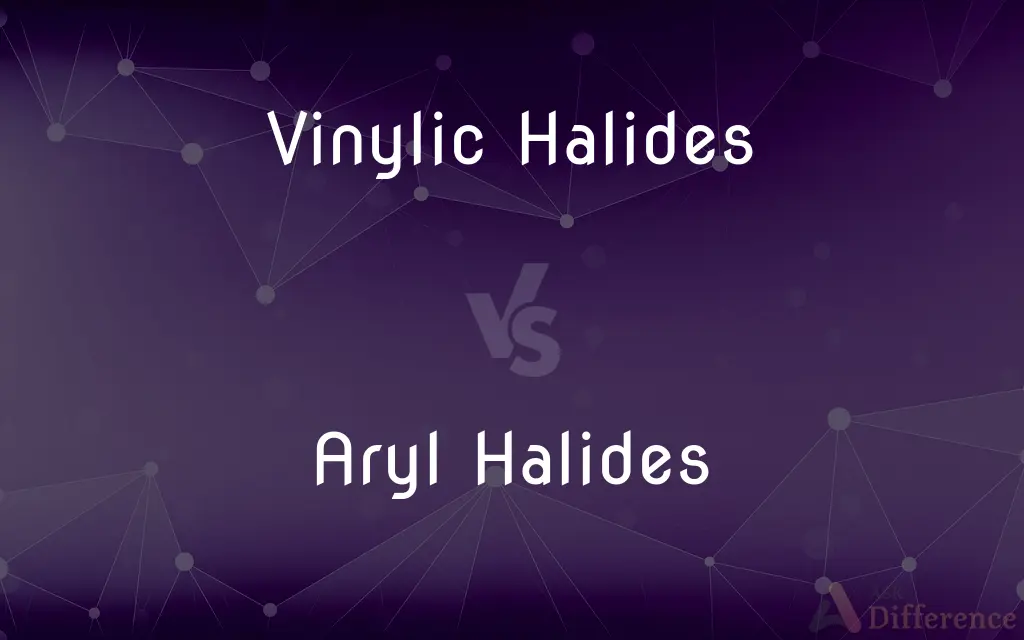Vinylic Halides vs. Aryl Halides — What's the Difference?
By Tayyaba Rehman — Published on January 30, 2024
Vinylic halides have a halogen atom bonded to a carbon-carbon double bond, while aryl halides have a halogen bonded to a carbon in a benzene ring.

Difference Between Vinylic Halides and Aryl Halides
Table of Contents
ADVERTISEMENT
Key Differences
Vinylic halides are characterized by the presence of a halogen atom attached to a carbon that is part of a carbon-carbon double bond. This configuration imparts unique chemical properties, such as reactivity and stability, which are distinct from other halogen-containing compounds. Conversely, aryl halides are defined by a halogen atom bonded directly to a carbon atom that is part of an aromatic ring, typically a benzene ring. This structural feature significantly influences their chemical behavior, making them less reactive in certain types of chemical reactions compared to vinylic halides.
The reactivity of vinylic halides in nucleophilic substitution reactions is notably lower compared to other types of alkyl halides, a characteristic attributed to the electron density and steric hindrance around the vinylic carbon. Aryl halides, on the other hand, also exhibit reduced reactivity in these reactions, primarily due to the partial double bond character introduced by resonance in the aromatic ring, which stabilizes the halogen-carbon bond.
In terms of synthesis, vinylic halides are typically prepared through the addition of halogens to alkenes, a process that requires specific conditions to avoid the formation of dihalogenated products. Aryl halides are commonly synthesized through electrophilic aromatic substitution, a reaction that involves the replacement of a hydrogen atom in the aromatic ring with a halogen, often facilitated by a catalyst.
The physical properties of vinylic halides, such as boiling points and densities, are influenced by the halogen's electronegativity and the molecule's overall geometry. Aryl halides, in contrast, have physical properties that are heavily impacted by the aromatic system's conjugation and the halogen's interaction with the π-electrons of the ring.
Vinylic halides are utilized in various organic synthesis reactions, serving as intermediates in the preparation of other functional groups. Aryl halides find their applications in the synthesis of pharmaceuticals, dyes, and polymers, leveraging their ability to undergo reactions that form carbon-carbon bonds, a cornerstone in the construction of complex organic molecules.
ADVERTISEMENT
Comparison Chart
Bond Type
Halogen bonded to sp2 hybridized carbon in a double bond
Halogen bonded to sp2 hybridized carbon in an aromatic ring
Reactivity
Lower in nucleophilic substitutions due to steric hindrance
Lower due to resonance stabilization of the aromatic ring
Synthesis
Via addition of halogens to alkenes
Via electrophilic aromatic substitution
Physical Properties
Influenced by halogen and molecule geometry
Dominated by aromatic system's conjugation
Chemical Applications
Intermediates in organic synthesis
Used in pharmaceuticals, dyes, and polymer synthesis
Compare with Definitions
Vinylic Halides
Vinylic halides are characterized by the presence of a halogen atom attached to a carbon-carbon double bond.
The vinylic halide was synthesized by adding chlorine to the alkene.
Aryl Halides
Aryl halides are compounds in which a halogen is bonded to an aromatic ring's carbon.
The aryl halide was a crucial compound in the synthesis of the new drug.
Vinylic Halides
Vinylic halides are less reactive in nucleophilic substitution reactions compared to other halides.
Despite its reduced reactivity, the vinylic halide underwent substitution with the right catalyst.
Aryl Halides
Aryl halides exhibit reduced reactivity in nucleophilic substitution due to the aromatic ring's partial double bond character.
The aryl halide required harsher conditions to undergo the desired reaction.
Vinylic Halides
Vinylic halides are used in organic chemistry as reactive intermediates.
The chemist used the vinylic halide to synthesize a more complex molecule.
Aryl Halides
Aryl halides are commonly used as intermediates in the synthesis of complex organic molecules.
The scientist used the aryl halide to build the polymer's backbone.
Vinylic Halides
Vinylic halides exhibit unique reactivity patterns due to the double bond adjacent to the halogen.
The study focused on the reactivity of the vinylic halide under various conditions.
Aryl Halides
Aryl halides are known for their stability due to resonance in the aromatic system.
The stability of the aryl halide made it an excellent choice for the reaction.
Vinylic Halides
Vinylic halides are organic compounds where a halogen is bonded to an alkene carbon.
In the reaction, the vinylic halide served as a key intermediate.
Aryl Halides
Aryl halides are synthesized through electrophilic aromatic substitution, among other methods.
The production of the aryl halide was achieved by substituting a hydrogen on the benzene ring with bromine.
Common Curiosities
What are aryl halides?
Aryl halides are organic compounds with a halogen atom bonded to a carbon in an aromatic ring, like benzene.
Why are vinylic halides less reactive in nucleophilic substitutions?
Vinylic halides are less reactive due to steric hindrance and the electron density around the double bond.
How are aryl halides typically synthesized?
Aryl halides are commonly synthesized through electrophilic aromatic substitution reactions.
How are vinylic halides typically synthesized?
Vinylic halides are usually synthesized through the addition of halogens to alkenes.
What are the typical uses of vinylic halides in chemistry?
Vinylic halides are used as intermediates in the synthesis of various organic compounds.
Can aryl halides participate in electrophilic aromatic substitution reactions?
Yes, aryl halides can undergo electrophilic aromatic substitution reactions, where an electrophile replaces a hydrogen atom on the aromatic ring.
What are vinylic halides?
Vinylic halides are organic compounds with a halogen atom bonded to a carbon in a carbon-carbon double bond.
Why are aryl halides less reactive in nucleophilic substitutions?
Aryl halides are less reactive due to the resonance stabilization of the aromatic ring, which strengthens the halogen-carbon bond.
What are some common uses of aryl halides in industry?
Aryl halides are used in the synthesis of dyes, agrochemicals, and pharmaceuticals, among other applications.
What are the typical uses of aryl halides in chemistry?
Aryl halides are used in the synthesis of pharmaceuticals, dyes, and polymers.
Can vinylic halides undergo addition reactions?
Yes, vinylic halides can participate in addition reactions, especially under specific conditions.
Are aryl halides typically less reactive than vinylic halides?
Aryl halides are generally less reactive than vinylic halides due to the aromatic ring's stabilizing effect on the halogen-carbon bond.
Share Your Discovery

Previous Comparison
Beforeall vs. Beforeeach
Next Comparison
Christmas Cactus vs. Easter CactusAuthor Spotlight
Written by
Tayyaba RehmanTayyaba Rehman is a distinguished writer, currently serving as a primary contributor to askdifference.com. As a researcher in semantics and etymology, Tayyaba's passion for the complexity of languages and their distinctions has found a perfect home on the platform. Tayyaba delves into the intricacies of language, distinguishing between commonly confused words and phrases, thereby providing clarity for readers worldwide.
















































